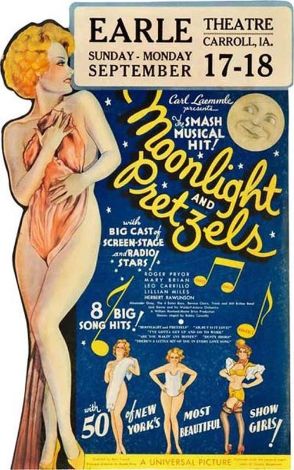Universal Pictures wasn't especially well known for its musicals -- the genre was dominated by Warner Bros., MGM, and Paramount for most of the 1930's and 1940's. But the studio's Moonlight And Pretzels does have its virtues, including some decidedly unusual ones. For starters, it was shot at the Astoria Studios in Queens, not in Hollywood, and while there are a few standard Hollywood faces in the cast (most notably William Frawley as the gruff stage manager), the leading man, Roger Pryor, was working on the New York stage at the time and much of the rest of the supporting cast was East Coast and, thus, offbeat for anything coming out of a Hollywood studio. The plot and the feel are a blatant imitation of Warner Bros.' 42nd Street, which had opened five months earlier, but there are some twists -- yes, the main body of the story revolves around the almost heartbreaking efforts to mount a Broadway show, overcoming various financing obstacles, shady dealings, and romantic entanglements, and the backstage banter is similarly paced and textured -- but focus of the story centers on the music and the composer (who also happens to be the producer of the show), and in Roger Pryor's George Dwight, we have hints of a kind of fictionalized George Gershwin; Dwight is a song-plugger with talent and ambition at the start, and amid his success as a popular songwriter, he longs to write music that will endure, perhaps even past his own lifetime, and even equates his ambition with the music of Franz Liszt (who was very much an inspiration for Gershwin in real-life). And then there's Lillian Miles' portrayal of the show's star -- she not only looks great but she sings up a storm, whether it's the Herman Hupfeld-authored "Honey Are You Makin' Any Money" or the E.Y. Harburg/Jay Gorney "Ah, But Is It Love?", the latter done both ballad-style and hot. And then there's that wonderful extended final production number, "Dusty Shoes", which is filled with dazzling, Busby Berkeley-ish choreography and images, intermixed with film super-imposition and other effects, and even some shots right out of German expressionist cinema (especially Metropolis), all the while telling the story of the 1929 stock market crash, and the Great Depression, and the heartbreak and hope that surrounded Franklin Roosevelt's election to the presidency. The latter may sound like a crude or awkward component for a musical number, but director Karl Freund -- best known for the horror film The Mummy (1932) -- pulls it off with amazing dexterity, helped by the choreography of Bobby Connolly. Despite its derivative nature, this is a lost gem of a movie, and one that deserves to be seen and acknowledged.

Moonlight and Pretzels (1933)
Directed by Monte Brice / Karl Freund
Genres - Musical |
Release Date - Aug 1, 1933 (USA - Unknown) |
Run Time - 80 min. |
Countries - United States |
MPAA Rating - NR
Share on